2.1 Cell Structure and Function, 2.9 Cell Compartmentalization
1/24
There's no tags or description
Looks like no tags are added yet.
Name | Mastery | Learn | Test | Matching | Spaced |
|---|
No study sessions yet.
25 Terms
Ribosomes
compromised of ribosomal RNA and protein
non-membrane
found in cells in all forms of life and reflect the common ancestry in all known life
function is to synthesize proteins (translate messages found on mRNA into primary structure of polypeptides)
can be found in the cytosol or bound to the ER or nuclear envelope
if found in the cytosol, proteins produced there generally function only within the cytosol(ex. enzymes), known as “free ribosomes”
if found bounded to ER or nuclear envelope, proteins produced there can be secreted from the cell and leave via transport vesicles
Compartmentalization
eukaryotic membranes and membrane-bound organelles allow for compartmentalization(different metabolic processes and enzymatic reactions occur in different locations)
increases surface area for reactions to occur
prevents interfering reactions from occurring in the same location
even though prokaryotes lack membrane bound organelles and don’t have compartmentalization, prokaryotes can have internal regions with specialized structuctures and functions ex. proteins involved in motility and cell division can be localized to carry out their specific function
Endomembrane system
Organelles and subcellular components that interact (directly or via vesicles) to modify, package, and transport polysaccharides, proteins, and lipids in the cell
Nuclear envelope
Endoplasmic reticulum (ER)
Golgi complex
Lysosomes
Transport vesicles/vacuoles
Plasma membrane
(not a specific order for everything just all the organelles involved)
Nuclear envelope
surrounds the nucleus
double membrane
has pores that regulate entry and exit of materials from the cell
continuous with the ER membrane
contains a nucleolus(in the nucleus)
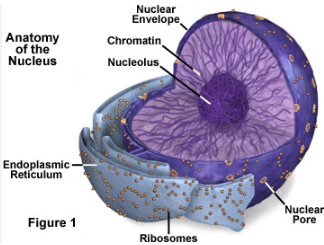
Nucleus
contains genetic material
contains the nucleolus
Nucleolus
dense region of the nucleus where ribosomal RNA (rRNA) is synthesized
rRNA is combined with proteins to form large and small subunits of ribosomes
subunits exit via nuclear pores and assemble into ribosomes
Endoplasmic reticulum (ER)
a network of membranous sacs (cisternae) and tubules
function is the provide mechanical support by helping cells maintain shape and intracellular transport
2 types: Rough and smooth
Rough ER
contains ribosomes bound to the ER membrane
compartmentalizes protein synthesis
folds and modifies newly synthesized proteins
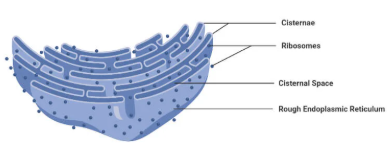
Smooth ER
contains no ribosomes
synthesizes lipids and detoxifies the cell
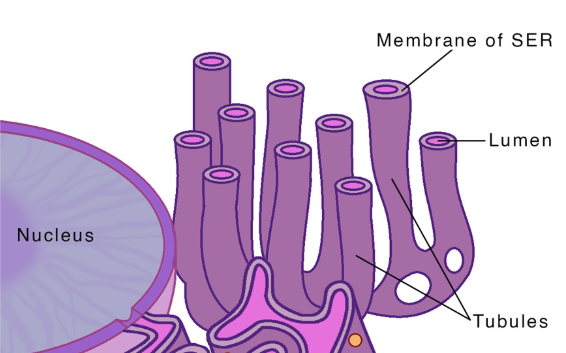
Golgi Complex
contains flattened membranous sacs called cisternae
separate the sacs from the cytosol
has directionality
cis face receives vesicles from the ER
trans face sends vesicles back out into the cytosol to other locations or to the plasma membrane for secretion
function is to receive transport vesicles with materials from the ER, modify the materials(correctly fold and chemically modify newly formed cellular products like proteins), sorts the materials, adds molecular tags, and packages materials into new transport vesicles that exit the membrane via exocytosis
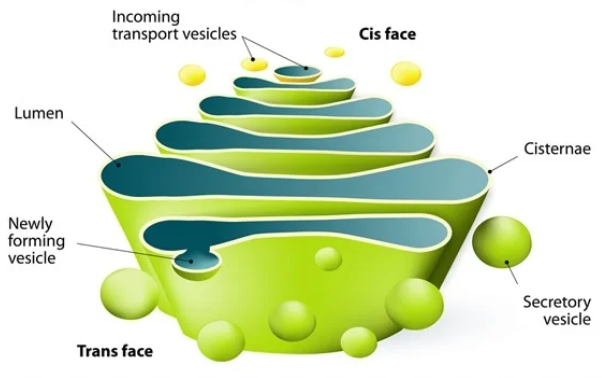
Plasma membrane
separates internal cell environment from external environment
selectively permeable(regulars what materials can enter and exit)
proteins are embedded in the cell here or secreted outside the cell via exocytosis
Lysosomes
membranous sac with hydrolytic enzymes in animal cells
only in animal cells
function is to hydrolyze (digest/break down) macromolecules and autophagy
plays a role in apoptosis (programmed cell death)-membrane becomes permeable—>releases enzymes into cytoplasm→breaks down cellular components
Autophagy
lysosomes can recycle their own cell’s organix materials and organelles that are not functioning properly
allows the cell to renew itself
steps:
a membrane forms around the cellular component targeted for degradation
membrane engulfs cellular components(forming a structure called an autophagosome)
fuses with lysosome
hydrolytic enzymes in lysosome digest the organelles and their components are recycled(amino acids and other small molecules are released back into the cytoplasm)

Vesicles
a small, membrane-bound sac within a cell that functions to transport, store, or digest cellular substances, such as proteins and lipids
crucial for moving materials within a cell and interacting with other cells by playing key roles in endocytosis, exocytosis, and intracellular transport between organelles like the endoplasmic reticulum and the Golgi apparatus
Vacuoles
vesicles that stem from the ER and the Golgi
selective in transport
in animal cells they are small in size;more per cell, assist in endocytosis/exocytosis processes, and store cellular materials
in plant cells there is a central vacuole;large in size, stores nutrients and water;important for turgor pressure(applies pressure on the cell wall with water to maintain structure), can function like lysosomes
Peroxisomes
membrane bound metabolic compartment
not a part of the endomembrane system
catalyze reactions that produce H2O2(hydrogen peroxide)
H2O2 can detoxify certain compounds, but can damage the cell if any escapes, so enzymes in peroxisomes (catalase) then break down H2O2 to water and oxygen
function is to break down fatty acid molecules, synthesize certain phospholipids, and detoxify compounds
Mitochondria
energy organelle
site of cellular respiration(produces ATP)
structure of the double membrane:
outer membrane is smooth, inner membrane is highly convoluted(meaning it has many folds);these folds are called cristae
cristae divide the mitochondria into two internal compartments, intermembrane and mitochondrial matrix, and increases the surface area
the intermembrane is the space between the inner and outer membrane
the number of mitochondria in a cell correlates with metabolic activity
cells with high metabolic activity have more mitochondria ex. cells that move and contract
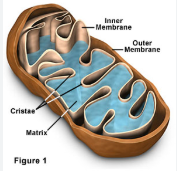
Mitochondrial matrix
enclosed by inner membrane
location for the Krebs cycle
contains enzymes that catalyze cellular respiration and produce ATP, mitochondrial DNA, and ribosomes
Chloroplast
energy organelle
specialized organelles in plants and photosynthetic algae
site of photosynthesis
contains the green pigment chlorophyll
inside of its double membrane are thylakoids and stroma
Thylakoids
membranous sacs that can organize into stacks called grana
light dependent reactions occur in grana
Stroma
fluid around thylakoids
location for the calvin cycle
contains chloroplast DNA, ribosomes, and enzymes
Cytoskeleton
a network of fibers throughout the cytoplasm
give structural support(especially for animal cells) and mechanical support using anchor organelles
-allows for movement of vesicles and organelles and/or the whole cell(movement occurs when the cytoskeleton interacts with motor proteins)
3 types of fibers in the cytoskeleton are microtubules, microfilaments, and intermediate filaments
Microtubules
thickest filament in the cytoskeleton
in animal cells they grow from the centrosome
function is to serve as structural support(think tracks) for the movement of organelles that are interacting with motor proteins, assist in the movement of chromosomes during cell division, and cell motility (ex. cilia and flagella)
Microfilaments
thin, solid rods made of the protein actin
function is to maintain cell shape by bearing tension, assist in muscle contraction and cell motility (actin works with another protein called myosin to cause a contraction), division of animal cells(contractile ring of the cleavage furrow)
Intermediate Filaments
fibrous proteins made up of varying subunits
permanent structural elements of cells
function is to maintain cell shape, anchor nucleus and organelles, form the nuclear lamina(lines the nuclear envelope)